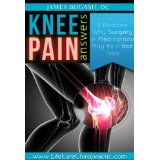Knee osteoarthritis symptoms. For some, it seems like the diagnosis is pretty much the same as saying that surgery is inevitable.
There are times when I think that more information is a bad thing. There have been countless times in my practice where someone gets hooked on imaging findings (whether they are MRI, CT scans or X-rays) and focuses on what damage is present rather then what is reality.
Whether it’s a shoulder, low back, neck or knee imaging study, there have been multiple studies pointing out two very important problems. First, there is very little correlation between imaging findings and symptoms. In other words, if someone has “stuff” wrong on a MRI, it does NOT mean this person is going to have pain. You cannot look at a MRI and state that this patient will or will not have pain.
This misconception then leads to the second problem. There is a large chunk of the surgical field that is devoted to doing procedures based on stuff we find on imaging. Got a disc bulge? Cut it out. Have knee osteoarthritis? Replace the knee. Torn rotator cuff? Surgical repair of the shoulder.
This particular study highlights just how wrong this approach is. In yet another study on the relationship between arthroscopic surgery of the knee for arthritis found on imaging and beneficial outcomes of the surgery, researchers looked at the results across 9 different medical trials. Specifically, these middle aged and older patients with knee pain and degenerative knee disease underwent knee arthroscopic surgery. Here’s what they found after an average of 2 years had passed after the surgeries:
- There was a very small benefit to surgery in patients’ pain levels (basically, a benefit of 2.4 mm on a 0-100 mm scale).
- There was no significant benefit on physical function.
- Harms included symptomatic deep venous thrombosis, pulmonary embolism, infection, and death.
The bottom line is that, going in for surgery just to “clean out” the knee has virtually no benefit but a list of risks. This is a procedure that, frankly, should no longer be done except in rare cases (and I don’t know exactly what these cases might look like…).
So what can you do instead of surgery?
- Move. Not exercising is one of the worst possible things you can do for knee arthritis. Hiking, swimming, weights, stationary bike, whole body vibration–there are lots of things you can do to strengthen your knees.
- Find a chiropractic who can competently treat the soft tissues of the knees–look for those that do Graston, ART, NMR, fascial manipulation.
- Consider a TENS unit to control the pain in the short run.
- Consider a joint support formula with glucosamine in it.
- Add vitamin D to your supplement list.
- Get down to your ideal body weight.
By using these tools to help manage your knee osteoarthritis symptoms, you won’t ever need to worry about whether or not the risks of surgery outweigh the miniscule benefits.

